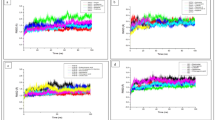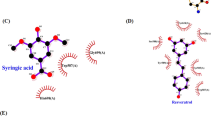Abstract
Increased blood sugar levels in prolonged diabetes lead to secondary complications such as retinopathy, neuropathy, and nephropathy, which gradually end in death. Synthesis of nano-phytomedicines from active phytoconstituents for novel emerging applications in the field of pharmaceuticals is of huge interest among researchers. In the present investigation, encapsulated ellagic acid (NEA) was synthesized at four different concentrations (0.2%, 0.3%, 0.4%, 0.5%) using ZnO nanoparticles as encapsulating agent. The surface morphology (fiber-like structures) of the nanoparticles were determined by scanning electron microscopy (SEM) and particle size (161–297 nm) and zeta potential (− 54.9–38.4 mV) were determined by dynamic light scattering technique. Further, the α-glucosidase and aldose reductase enzymes were significantly inhibited by the 0.4% of NEA compared to the other concentrations which strengthened our studies in overcoming the secondary complications of diabetes. The interaction analysis between ellagic acid and insulin receptor found Hit 1 among 10 executed ∆G score and energy of − 5.76, − 4.63 kcal/mol and formed polar bond with Arg 113 with − 1.175 Å distance. The residues Arg115, Lys116, Phe118, Ile115, Arg1131, Arg1155, Ile1157, Lys1165 and Phe1186 were found in ligand–protein interactions. ADME/T analysis of hit 1 was within the acceptable range without any toxic functional groups, providing a framework for developing novel therapeutics.










Similar content being viewed by others
References
Ahmad N, Umar S, Ashafaq M, Akhtar M, Iqbal Z, Samim M, Ahmad FJ (2013) A comparative study of PNIPAM nanoparticles of curcumin, demethoxycurcumin, and bisdemethoxycurcumin and their effects on oxidative stress markers in experimental stroke. Protoplasma 250(6):1327–1338
Bikadi Z, Hazai E (2009) Application of PM6 semi-empirical method to modeling protein enhances docking accuracy of AutoDock. J Cheminform 11:1–15
Brahmam NH, Ajay KSR, Wasi K, Alim H, Naqvi BRJ (2014) Biosynthesis of stable antioxidant ZnO nanoparticles by Pseudomonas aeruginosa rhamnolipids. PLoS ONE 9(9):e106937
Dahlqvist A, Borgstrom B (1961) Digestion and absorption of disaccharides in man. Biochem J 81:411–418
Du J, Sun H, Xi L, Li J, Yang Y, Liu H, Yao X (2011) Molecular modeling study of checkpoint kinase 1 inhibitors by multiple docking strategies and prime/MM-GBSA calculation. J Comput Chem 32:2800–2809
Duhonvy D, Nussinov R, Wolfson HJ (2002) Efficient unbound docking of rigid molecules, in Gusfield wt al., Ed proceeding of the 2nd workshop on algorithm in Bioinformatics (WABI) Rome, Italy, Lecture Notes in Computer Science, 2452, pp.185–200, Springer Verlag.
Etheridge ML, Campbell SA, Erdman AG, Christy LH, Susan MW (2013) The big picture on nanomedicine: the state of investigational and approved nanomedicine products. Nanomedicine 9:1–14
Feng L, Zhang C, Gao G, Cui D (2012) Facile synthesis of hollow Cu2O octahedral and spherical nanocrystals and their morphology-dependent photocatalytic properties. Nanoscale Res Lett 7:1–10
Gunalan S, Rajeshwari S, Venkatesh R (2012) Green synthesized ZnO nanoparticles against bacterial and fungal pathogens. Prog Nat Sci 22:693–700
Hayman S, Kinoshita JH (1965) Isolation and properties of lens aldose reductase. J Biol Chem 240:877–882
Hema K, Vani Priyadarshini I, Sandeep S, Pradeep N, Chiranjeevi P, Umamaheswari A (2015) Subunit vaccine design against pathogens causing atherosclerosis. J Biomol Struct Dyn 33(supplement 1):135–136
Hema K, Sandeep S, Pradeep N, Umamaheswari A (2016) Identification of effectual inhibitors against human insulin like growth factor binding protein-2. J Inform Data Min 2(1):1–10
Hema K, Sandeep S, Pradeep N, Umamaheswari A (2019) In silico identification of leads targeting Interleukin-6 against pathogenesis of atherosclerosis. J Biomol Struct Dyn 1:32–33
Jorgensen WL, Maxwell DS, Tirado-Rives J (1996) Development and testing of the OPLS all-atom force field on conformational energetics and properties of organic liquids. J Am Chem Soc 118:11225–11236
Junghanns JU, Müller RH (2008) Nanocrystal technology, drug delivery and clinical applications. Int J Nanomedicine 3(3):295–309
Kanipakam H, Sharma K, Thinlas T, Mohammad G, Pasha MAQ (2020) Structural and functional alterations of nitric oxide synthase 3 due to missense variants associate with high-altitude pulmonary edema through dynamic study. J Biomol Struct Dyn 17:1–16
Kavitha P, Saritha M, Laxma Reddy K (2012) Synthesis, structural characterization, fluorescence, antimicrobial, antioxidant and DNA cleavage studies of Cu(II) complexes of formyl chromone Schiff bases. Spectrochim Acta A Mol Biomol Spectrosc 102:159–168
Khosravi A, Jayaram B, Goliaei B, Masoudi-Nejad A (2019) Active repurposing of drug candidates for melanoma based on GWAS, PheWAS and a wide range of omics data. Mol Med 25(1):30. https://doi.org/10.1186/s10020-019-0098-x
Kim HS, Quon MJ, Kim JA (2014) New insights into the mechanisms of polyphenols beyond antioxidant properties; lessons from the green tea polyphenol, epigallocatechin 3-gallate. Redox Biol 2:187–195
Knox C, Law V, Jewison T, Liu P, Ly S, Frolkis A (2011) DrugBank 3.0: a comprehensive resource for ‘omics’ research on drugs. Nucleic Acids Res 39:D1035–1041
Kollman PA, Massova I, Reyes C, Kuhn B, Huo S, Chong L et al (2000) Calculating structures and free energies of complex molecules: combining molecular mechanics and continuum models. Acc Chem Res 33:889–897
Kushwaha SK, Shakya M (2010) Protein interaction network analysis—approach for potential drug target identification in Mycobacterium tuberculosis. J Theor Biol 262:84–294
Lee S, Lee IH, Kim HJ, Chang GS, Chung JE, No KT (2002) The Pre ADMET Approach: Web based program for rapid prediction of physico-chemical, drug absorption and drug-like properties. Euro QSAR 2002-designing drugs and crop, Protectants: processes problems and solutions, 1: 418–412.
Li J, Abel R, Zhy K, Cao Y, ZhaoFriensner SRA (2011) The VSGB 2.0 model: the next generation energy model for high resolution protein structure modeling. Proteins 79:2794–2812
Liang J, Edelsbrunner H, Fu P, Sudhakar PV, Subramaniam S (1998) Analytical shape computation of macromolecules: II. Identification and computation of inaccessible cavities in proteins. Proteins 33:18–29
Lipinski CA, Hopkins A (2004) Navigating chemical space for biology and medicine. Nature 432:855–861
Lobo V, Patil A, Phatak A, Chandra N (2010) Free radicals, antioxidants and functional foods impact on human health. Pharmacogn Rev 4:118–216
Marella S, Dilip Rajasekhar M, Kumar EGTV, Krishna Tilak T, Kameswara Rao B, Apparao Ch (2016) Mcy protein, a potential antidiabetic agent: evaluation of carbohydrate metabolic enzymes and antioxidant status. Int J Biol Macromol 86:481–488
Mavromoustakos T, Durdagi S, Koukoulitsa C, Simcic M, Papadopoulos MG, Hodoscek M, Grdadolnik SG (2011) Strategies in the rational drug design. Curr Med Chem 18:2517–2530
Merisko-Liversidge and Liversidge (2011) Nanosizing for oral and parenteral drug delivery: a perspective on formulating poorly-water soluble compounds using wet media milling technology. Adv Drug Deliv Rev 63:427–440
Mohammad A, Bhawani SA, Sharma S (2010) Analysis of herbal products by thin layer chromatography: a review. Int J Pharma Bio Sci 1(2):10
Mondal SI, Ferdous S, Jewel NA, Akter A, Mahmud Z, Islam MM, Afrin T, Karim N (2015) Identification of potential drug targets by subtractive genome analysis of Escherichia coli O157:H7: an in silico approach. Adv Appl Bioinform Chem 8:49–63
Murata M, Ohta N, Sakurai S, Alam S, Tsai J, Kador PF, Sato S (2001) The role of aldose reductase in sugar cataract formation: aldose reductase plays a key role in lens epithelial cell death (apoptosis). Chem Biol Interact 130–132(1–3):617–625
Papadimitriou S, Bikiaris D (2009) Novel self-assembled core–shell nanoparticles based on crystalline amorphous moieties of aliphatic copolyesters for efficient controlled drug release. J Control Release 138(2):177–184
Perron NR, Brumaghim JL (2009) A review of the antioxidant mechanisms of polyphenol compounds related to iron binding. Cell Biochem Biophys 53:75–100
Pradeep P, Jayaram B (2019) C5’ omitted DNA enhances bendability and protein binding. Biochem Biophys Res Commun. https://doi.org/10.1016/j.bbrc.2019.05.051
Prasad TNVKV, Sudhakar P, Sreenivasulu Y, Latha P, Munaswamy V, Raja Reddy K, Sreeprasad TS, Sajanlal PR, Pradeep TJ (2012) Effect of titanium dioxide and zinc oxide nanoparticles on germination and vigour in tomato (Solanum lycopersicum L.) seeds. Plant Nutr 35(6):851–869
Raoufi D (2013) Synthesis and photoluminescence characterization of ZnO nanoparticles. J Lumin 134:213–219
Rasha M, Patra D (2016) Modification of nanostructured ZnO surfaces with curcumin: fluorescence-based sensing for arsenic and improving arsenic removal by ZnO. RSC Adv 6:17256–17268
Revina AA, Oksentyuk EV, Fenin AA (2007) Synthesis and properties of zinc nanoparticles: the role and prospects of radiation chemistry in the development of modern nanotechnology. Prot Met 43:613–618
Roy PS, Bhattacharya SK (2013) Size-controlled synthesis and characterization of polyvinyl alcohol-coated platinum nanoparticles: role of particle size and capping polymer on the electrocatalytic activity. Catal Sci Technol 3:1314–1323
Shukla VK, Singh JS, Vispute N, Ahmad B, Kumar A, Hosur RV (2017) Unfolding of CPR3 gets initiated at the active site and proceeds via two intermediates. Biophys 112:605–619
Stark C, Breitkreutz BJ, Reguly T, Boucher I, Breitkreutz A, Tyers M (2006) BioGRID: a general repository for interaction datasets. Nucleic Acids Res 34:535–539
Szklarczyk D, Franceschini A, Wyder S, Forslund K, Heller D (2014) STRING v10: protein–protein interaction networks, integrated over the tree of life. Nucleic Acids Res 43:D447–D452
Tripathi SK, Muttineni R, Singh SK (2013) Extra precision docking, free energy calculation and molecular dynamics simulation studies of CDK2 inhibitors. J Theor Biol 334:87–100
Williamson J, Kilo C, Tilton RG (1992) Mechanism of glucose and diabetes-induced vascular dysfunction. In: Ruderman N, Williamson J, Brownlee M (eds) Hyperglycemia, Diabetes and Vascular Disease. American Physiological Society, New York, NY, pp 107–132
Wright LP, Rohwer JM, Ghirardo A, Hammerbacher A, Ortiz-Alcaide M (2014) Deoxyxylulose 5-phosphate synthase controls flux through the methylerythritol 4-phosphate pathway in arabidopsis. Plant Physiol 165:1488–1504
Zafar S, Ahmed R, Khan R (2016) Biotransformation; a green and efficient way of antioxidant synthesis. Free Radic Res 27:1–10
Acknowledgements
The project was supported by the Department of Science and Technology (DST)—Science and Engineering Research Board (SERB) under National Post Doctoral Fellowship (PDF/2015/000534).
Author information
Authors and Affiliations
Corresponding author
Ethics declarations
Conflict of interest
The authors declare no competing financial interest.
Electronic supplementary material
Below is the link to the electronic supplementary material.
Rights and permissions
About this article
Cite this article
Marella, S., Hema, K., Shameer, S. et al. Nano-ellagic acid: inhibitory actions on aldose reductase and α-glucosidase in secondary complications of diabetes, strengthened by in silico docking studies. 3 Biotech 10, 439 (2020). https://doi.org/10.1007/s13205-020-02411-1
Received:
Accepted:
Published:
DOI: https://doi.org/10.1007/s13205-020-02411-1




